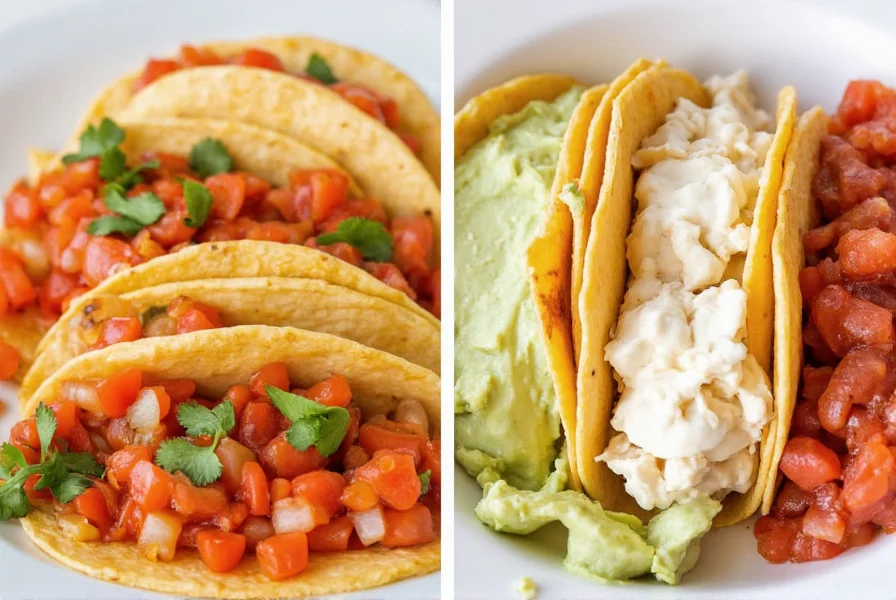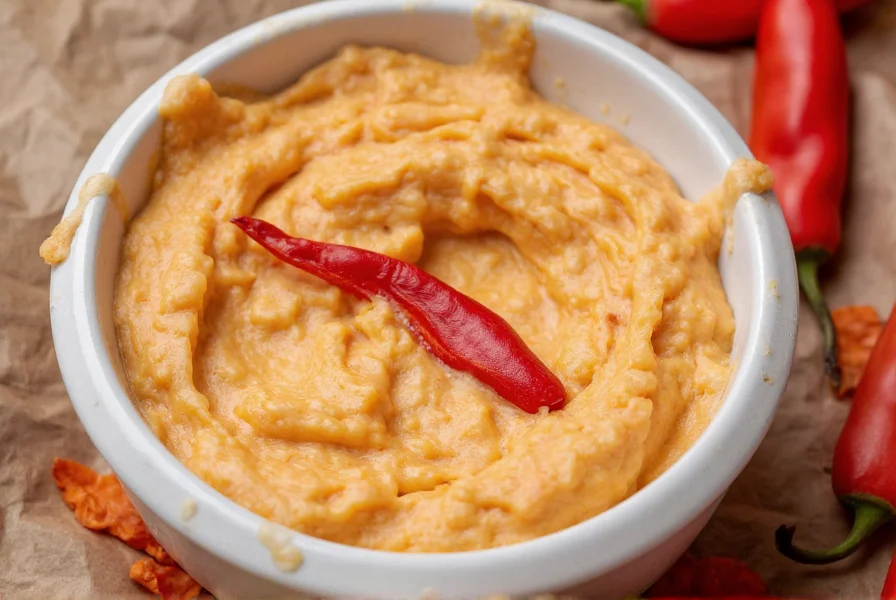Red pepper crema has become a staple in modern Southwestern and fusion cuisine, prized for its balance of smoky depth and creamy richness. Unlike heavier aioli or mayonnaise-based sauces, this vibrant orange condiment delivers bold roasted pepper flavor without overwhelming dishes. Chefs and home cooks alike value its ability to elevate simple ingredients while accommodating various dietary preferences when made with dairy-free alternatives.
What Exactly Is Red Pepper Crema?
Red pepper crema is a smooth, pourable sauce blending roasted red bell peppers with a creamy base—typically Mexican crema, sour cream, or Greek yogurt. The roasted peppers provide natural sweetness and subtle smokiness, while the dairy component creates a luxurious texture that clings perfectly to foods. This sauce differs from similar condiments through its specific balance: thinner than roasted red pepper dip but thicker than standard hot sauce, with pH levels that enhance food safety compared to raw pepper salsas.
Authentic versions use fire-roasted peppers for genuine char flavor rather than liquid smoke additives. The traditional Spanish "crema" refers to a cultured dairy product similar to crème fraîche, though many American recipes substitute sour cream for wider availability. Understanding how to make red pepper crema properly requires attention to pepper selection and emulsification techniques that prevent separation.
Flavor Profile and Culinary Applications
This vibrant sauce delivers a complex flavor journey: initial sweetness from perfectly roasted peppers, followed by tangy dairy notes, and finishing with optional hints of garlic, lime, or chipotle. The heat level remains mild unless additional spices are incorporated, making it family-friendly while still sophisticated enough for gourmet presentations.
| Food Pairing | Recommended Application | Flavor Enhancement |
|---|---|---|
| Tacos & Burritos | Drizzled inside or as finishing touch | Softens spice heat while adding moisture |
| Grilled Proteins | Marinade base or dipping sauce | Complements char marks with creamy contrast |
| Roasted Vegetables | Tossed before roasting or as drizzle | Creates caramelized flavor layers |
| Seafood | Light coating for fish tacos | Neutralizes fishiness without masking flavor |
Perfect Homemade Red Pepper Crema Recipe
Creating authentic red pepper crema recipe requires just six ingredients and fifteen minutes. This tested formula prevents common issues like watery consistency or flavor imbalance:

Ingredients
- 1 cup roasted red bell peppers (jarred or freshly roasted)
- ½ cup Mexican crema or full-fat sour cream
- 1 tablespoon fresh lime juice
- 1 small garlic clove, minced
- ¼ teaspoon smoked paprika
- Salt to taste (approximately ¼ teaspoon)
Step-by-Step Preparation
- Drain roasted peppers thoroughly, pressing out excess liquid with paper towels
- Combine all ingredients in food processor
- Pulse until completely smooth (about 45 seconds)
- Transfer to airtight container
- Refrigerate minimum 2 hours before serving
For roasted red pepper crema with deeper flavor, roast fresh peppers over open flame until charred, then steam in covered bowl before peeling. This technique develops complex flavor compounds that jarred peppers lack. The resting period allows flavors to meld and texture to stabilize—never skip this step when preparing homemade red pepper crema.
Ingredient Science: Why Each Component Matters
The magic of red pepper crema lies in ingredient synergy. Roasted peppers provide pectin that helps emulsify the sauce, while their natural sugars balance acidity. Mexican crema's lower fat content than mayonnaise creates a lighter mouthfeel without sacrificing creaminess. Fresh lime juice isn't just for acidity—it contains citric acid that prevents oxidation and color degradation.
Many amateur recipes fail by using watery jarred peppers without proper draining. Professional chefs recommend squeezing roasted peppers in cheesecloth to achieve the ideal 3:1 pepper-to-cream ratio. This precision transforms red pepper crema vs aioli—where aioli relies on egg yolk emulsification, crema uses pepper pectin for a more stable, dairy-forward profile.
Storage Guidelines and Shelf Life
Properly stored red pepper crema storage lasts 7-10 days in airtight containers. Key preservation factors:
- Maintain temperature below 40°F (4°C)
- Prevent cross-contamination with clean utensils
- Keep away from strong-smelling foods
Freezing diminishes texture quality due to dairy separation, though thawed sauce works well in cooked applications. Signs of spoilage include surface mold, sour odor beyond normal tanginess, or watery separation that doesn't reincorporate when stirred. For meal prep, make batches no larger than needed—this crema sauce recipe scales perfectly from single servings to catering quantities.
Variations for Dietary Needs and Flavor Exploration
Adapt this base red pepper crema recipe for various preferences:
- Vegan version: Substitute coconut cream and 1 teaspoon nutritional yeast
- Extra spicy: Add ½ teaspoon chipotle powder or 1 minced serrano pepper
- Herb-infused: Blend in 2 tablespoons fresh cilantro or basil
- Smoky depth: Include ¼ teaspoon liquid smoke (use sparingly)
For red pepper crema for tacos, many chefs add a pinch of cumin and increase lime juice to cut through rich meats. The sauce's versatility explains its popularity across restaurant menus—from high-end establishments to food trucks seeking that perfect finishing touch.
How It Compares to Similar Condiments
Understanding red pepper crema vs aioli reveals key differences. While both are creamy sauces, aioli is garlic-forward with olive oil base, whereas crema emphasizes roasted pepper flavor with dairy foundation. Unlike traditional mayonnaise-based sauces, red pepper crema has higher moisture content and lower fat percentage, making it more suitable for drizzling.
Compared to roasted red pepper dip, crema has thinner consistency designed for coating rather than scooping. This distinction matters when considering red pepper crema uses—it functions as both flavor enhancer and moisture provider in dishes where heavier sauces would overwhelm ingredients.

Frequently Asked Questions
Can I use regular mayonnaise instead of crema in red pepper crema?
Yes, but with texture and flavor adjustments. Mayonnaise creates a thicker, richer sauce that requires additional lime juice (1-2 teaspoons) to balance. For authentic red pepper crema recipe, use ⅓ cup mayonnaise blended with ⅓ cup Greek yogurt to approximate crema's tang and consistency.
Why does my homemade red pepper crema separate?
Separation typically occurs from excess moisture in peppers or inadequate emulsification. Always drain roasted peppers thoroughly and process ingredients until completely smooth (minimum 45 seconds). Adding ½ teaspoon xanthan gum prevents separation in commercial applications, though traditional recipes rely on proper technique rather than stabilizers for authentic homemade red pepper crema.
How spicy is traditional red pepper crema?
Authentic red pepper crema made solely with bell peppers has no heat—it's mildly sweet and tangy. Many modern variations incorporate chipotle peppers or cayenne for spice. When preparing red pepper crema for tacos, chefs often create two versions: mild for general use and spicy for specific menu items, allowing customization based on diner preferences.
What's the best way to roast peppers for crema?
For optimal flavor in roasted red pepper crema, roast peppers directly over gas flame or under broiler until blackened (8-10 minutes), turning frequently. Immediately place in covered bowl for 10 minutes to steam, then peel under running water. This method develops complex flavor compounds through controlled charring while preserving pepper integrity—superior to jarred alternatives for serious red pepper crema recipe execution.
Can red pepper crema be used as a salad dressing?
Absolutely—it makes an excellent base for Southwestern-style dressings. Thin red pepper crema with 1-2 tablespoons buttermilk or vinegar to achieve pourable consistency. The natural sweetness balances bitter greens while the creaminess carries herbs effectively. Many chefs prefer this over traditional ranch for wedge salads and grain bowls due to its brighter flavor profile that complements red pepper crema uses beyond Mexican cuisine.











 浙公网安备
33010002000092号
浙公网安备
33010002000092号 浙B2-20120091-4
浙B2-20120091-4